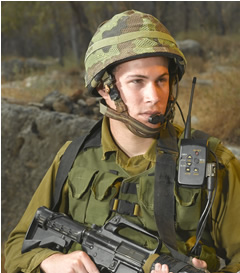 The Personnel Network Radio PNR-500 from Tadiran Communications is a small Personal Role Radio (PRR) UHF communicator operating in the 410-450MHz band, facilitating effective communications between infantry team members, over a very short range (over 1000 – 800 meters range). When such devices are distributed to all the troops of an infantry squad, these sets enable the squad leader to control his teams more effectively and quietly, while facilitating external communications to the company and other external networks. The PNR-500 is controlled via a specially designed hands free headset or remote activation switch. The individual sets are utilizing dynamic synchronization and and automatic clear channel tuning. They do not need a central control station. Each personal radio on a network can operate up to four separate subnets, allowing individual or intra-squad communications. The sets can also provide intercom when troops are mounted on an Armored Personnel Carrier (APC) and facilitate automatic routing of calls via the vehicle’s tactical Combat Net Radio (CNR). To improve coordination and stealth, the PNR-500 supports whisper mode, voice activated messages and alerts and up to 15 preset network channels. Enhanced models can also transfer data and link to add-on GPS module. Bluetooth support for wireless headset or other accessories is also available.
The Personnel Network Radio PNR-500 from Tadiran Communications is a small Personal Role Radio (PRR) UHF communicator operating in the 410-450MHz band, facilitating effective communications between infantry team members, over a very short range (over 1000 – 800 meters range). When such devices are distributed to all the troops of an infantry squad, these sets enable the squad leader to control his teams more effectively and quietly, while facilitating external communications to the company and other external networks. The PNR-500 is controlled via a specially designed hands free headset or remote activation switch. The individual sets are utilizing dynamic synchronization and and automatic clear channel tuning. They do not need a central control station. Each personal radio on a network can operate up to four separate subnets, allowing individual or intra-squad communications. The sets can also provide intercom when troops are mounted on an Armored Personnel Carrier (APC) and facilitate automatic routing of calls via the vehicle’s tactical Combat Net Radio (CNR). To improve coordination and stealth, the PNR-500 supports whisper mode, voice activated messages and alerts and up to 15 preset network channels. Enhanced models can also transfer data and link to add-on GPS module. Bluetooth support for wireless headset or other accessories is also available.



















